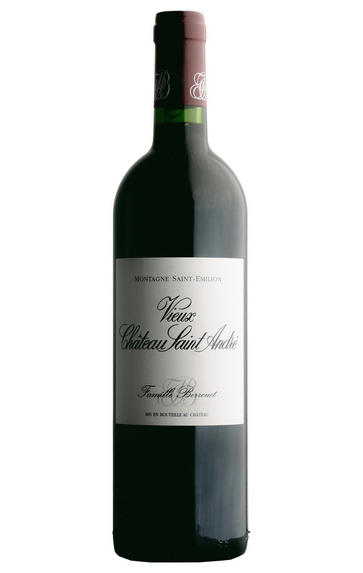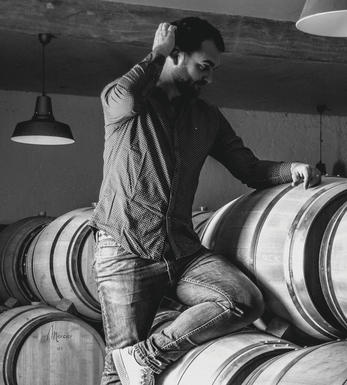
2020 Vieux Château Saint André, Montagne-St Emilion, Bordeaux

Critics reviews
Medium to deep garnet-purple in colour, the 2020 Vieux Château Saint André comes bounding out of the glass with exuberant notes of Morello cherries, juicy black plums and fresh blueberries, plus hints of bay leaves, lavender and fragrant soil. The medium to full-bodied palate is coated with vibrant red and black fruit layers with loads of mineral accents and a soft, plush texture, finishing long and refreshing.
Drink 2024 - 2039
Lisa Perrotti-Brown MW, Wine Advocate (May 2021)
Matured in 15% new oak, 10% in large clay jars and the rest in one or two wine barrels, the 2020 Vieux Château Saint André delivers aromas of graphite, liquorice and dark berries with an elegant earthy note. A bit firm and austere, the wine is medium to full-bodied on the palate with both structuring and powdery tannins as well as controlled power. A period in the cellar (4 to 10 years) will allow it to blossom.
Acquired by Jean-Claude Berrouet in 1985, Vieux Château Saint André comprises 22 hectares of vineyards at one of the highest points in Montagne Saint-Émilion (120 metres above sea level). The domaine is now run by one of his sons, Jeff Berrouet, but also benefits from the accumulated savoir-faire of Jean-Claude.
Producing impressively deep wines with rich structuring tannins, this domaine is managed traditionally, with cuvaison periods of 15–20 days, ageing with 15% new oak and 15% jars and the rest in barrels. Although a little austere in their youth, the wines blossom with some time in the cellar. The Berrouet family also owns Château Bonneau in Montagne, Château Hyon la Fleur in Saint-Émilion and Château Samion in Lalande-de-Pomerol.
Drink 2025 - 2028
Yohan Castaing, Wine Advocate (April 2023)
About this WINE

Vieux Ch. Saint André
North-east of St Emilion proper in the Montagne appellation, Jeff Berrouet lives and makes wine at Vieux Ch. Saint André. The 12-hectare property, in his family since 1978, is dubbed “a true insider’s wine” by Jane Anson in Inside Bordeaux.
If the family estate flies a little under the radar, the family names rings out loud and clear. A Berrouet has been the winemaker at Petrus since 1964; Jeff’s brother, Olivier, succeeded their father, Jean-Claude, there in 2008. Petrus – as with all the wines of Pomerol – is also unclassified, so Vieux Ch. Saint André is in good company. “My father has had a big influence on my philosophy,” says Jeff. “He likes to make a wine which can tell the story of its soil and its year. That’s important for us.”
Though Jeff uses modern techniques and equipment, he has learned from one of the best in Bordeaux and seems quite content to carry on the family tradition.

St Émilion
St Émilion is one of Bordeaux's largest producing appellations, producing more wine than Listrac, Moulis, St Estèphe, Pauillac, St Julien and Margaux put together. St Emilion has been producing wine for longer than the Médoc but its lack of accessibility to Bordeaux's port and market-restricted exports to mainland Europe meant the region initially did not enjoy the commercial success that funded the great châteaux of the Left Bank.
St Émilion itself is the prettiest of Bordeaux's wine towns, perched on top of the steep limestone slopes upon which many of the region's finest vineyards are situated. However, more than half of the appellation's vineyards lie on the plain between the town and the Dordogne River on sandy, alluvial soils with a sprinkling of gravel.
Further diversity is added by a small, complex gravel bed to the north-east of the region on the border with Pomerol. Atypically for St Émilion, this allows Cabernet Franc and, to a lesser extent, Cabernet Sauvignon to prosper and defines the personality of the great wines such as Ch. Cheval Blanc.
In the early 1990s there was an explosion of experimentation and evolution, leading to the rise of the garagistes, producers of deeply-concentrated wines made in very small quantities and offered at high prices. The appellation is also surrounded by four satellite appellations, Montagne, Lussac, Puisseguin and St. Georges, which enjoy a family similarity but not the complexity of the best wines.
St Émilion was first officially classified in 1954, and is the most meritocratic classification system in Bordeaux, as it is regularly amended. The most recent revision of the classification was in 2012

Cabernet Sauvignon Blend
Cabernet Sauvignon lends itself particularly well in blends with Merlot. This is actually the archetypal Bordeaux blend, though in different proportions in the sub-regions and sometimes topped up with Cabernet Franc, Malbec, and Petit Verdot.
In the Médoc and Graves the percentage of Cabernet Sauvignon in the blend can range from 95% (Mouton-Rothschild) to as low as 40%. It is particularly suited to the dry, warm, free- draining, gravel-rich soils and is responsible for the redolent cassis characteristics as well as the depth of colour, tannic structure and pronounced acidity of Médoc wines. However 100% Cabernet Sauvignon wines can be slightly hollow-tasting in the middle palate and Merlot with its generous, fleshy fruit flavours acts as a perfect foil by filling in this cavity.
In St-Emilion and Pomerol, the blends are Merlot dominated as Cabernet Sauvignon can struggle to ripen there - when it is included, it adds structure and body to the wine. Sassicaia is the most famous Bordeaux blend in Italy and has spawned many imitations, whereby the blend is now firmly established in the New World and particularly in California and Australia.


Buying options
Add to wishlist
Description
Matured in 15% new oak, 10% in large clay jars and the rest in one or two wine barrels, the 2020 Vieux Château Saint André delivers aromas of graphite, liquorice and dark berries with an elegant earthy note. A bit firm and austere, the wine is medium to full-bodied on the palate with both structuring and powdery tannins as well as controlled power. A period in the cellar (4 to 10 years) will allow it to blossom.
Acquired by Jean-Claude Berrouet in 1985, Vieux Château Saint André comprises 22 hectares of vineyards at one of the highest points in Montagne Saint-Émilion (120 metres above sea level). The domaine is now run by one of his sons, Jeff Berrouet, but also benefits from the accumulated savoir-faire of Jean-Claude.
Producing impressively deep wines with rich structuring tannins, this domaine is managed traditionally, with cuvaison periods of 15–20 days, ageing with 15% new oak and 15% jars and the rest in barrels. Although a little austere in their youth, the wines blossom with some time in the cellar. The Berrouet family also owns Château Bonneau in Montagne, Château Hyon la Fleur in Saint-Émilion and Château Samion in Lalande-de-Pomerol.
Drink 2025 - 2028
Yohan Castaing, Wine Advocate (April 2023)
wine at a glance
Delivery and quality guarantee